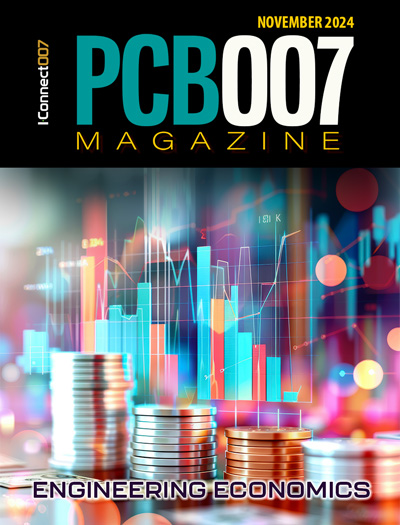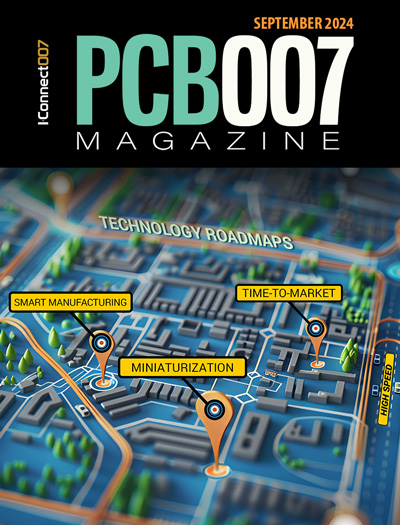-

- News
- Books
Featured Books
- pcb007 Magazine
Latest Issues
Current Issue
Engineering Economics
The real cost to manufacture a PCB encompasses everything that goes into making the product: the materials and other value-added supplies, machine and personnel costs, and most importantly, your quality. A hard look at real costs seems wholly appropriate.

Alternate Metallization Processes
Traditional electroless copper and electroless copper immersion gold have been primary PCB plating methods for decades. But alternative plating metals and processes have been introduced over the past few years as miniaturization and advanced packaging continue to develop.

Technology Roadmaps
In this issue of PCB007 Magazine, we discuss technology roadmaps and what they mean for our businesses, providing context to the all-important question: What is my company’s technology roadmap?
- Articles
- Columns
Search Console
- Links
- Media kit
||| MENU - pcb007 Magazine
Beyond Liquid Crystal: DARPA Seeks Novel Tunable Optical Materials
June 13, 2023 | DARPAEstimated reading time: 3 minutes
Liquid crystals are ubiquitous tunable optical materials most commonly known for the vibrant colors and sharp images they enable on flatscreen TVs, smartphones, tablets, and monitors. Despite being well-suited for optical filtering in visual displays, liquid crystals are not effective for militarily relevant areas of interest in both visible and infrared spectral regions.
DARPA’s Accelerating discovery of Tunable Optical Materials (ATOM) program aims to discover and develop new tunable optical materials (TOMs) in the visible and mid- and longwave infrared (MWIR/LWIR) bands of the electromagnetic spectrum. The ultimate goal is to enable solid-state materials that can be optically tuned on demand across multiple spectral ranges without requiring physical filtering or mechanical input to achieve this dynamic functionality. Such a breakthrough could enable low size, weight, and power single-lens optical devices to carry out a wide array of warfighter missions.
“Liquid crystals are relatively large molecules with slow switching speeds – operating around the same refresh rate that our eyes can perceive changes – and, because they’re liquid, they aren’t easily integrated with other technologies,” said Rohith Chandrasekar, ATOM program manager in DARPA’s Defense Sciences Office. “For these reasons liquid crystals are not useful for applications where we need very fast switching speeds, like laser beam steering, or correcting for atmospheric turbulence in an image where the turbulence is much faster than our eyes can perceive.”
Some new phase change materials show tentative promise for the infrared spectrum. However, since phase changes between the amorphous and crystalline states are induced by thermal energy, these materials are unable to attain and maintain the desired phase-switching speed, limiting their utility in the MWIR/LWIR applications. New understanding of material physics is needed to enable tunable materials with non-thermally modulated properties.
ATOM comprises two technical areas: infrared and visible spectrum tunable optical materials. The program seeks to discover and develop tunable materials that provide very fast tuning speed, allow for large tunability in their optical properties (i.e., refractive index), and can be integrated with traditional foundry processes for production.
A materials breakthrough in ATOM could benefit a multitude of different technology platforms.
"For example, tunable optics would enable much smaller and lighter mobile imaging platforms like telescopes and drones that can correct for the image blur that comes from turbulence in the air," Chandrasekar said. "Tunable optical filters could also simplify hyperspectral imaging systems used in applications like remote chemical sensing, thermal imaging, and food security. We hope the tunable optical materials discovered and developed in ATOM will allow us to eventually achieve these visions."
Identifying novel optical materials with unique tunable properties across a broad bandwidth requires new data science and learning-based approaches. To date, optical material discovery is largely based on intuitive design coupled with first-principles simulations, like density functional theory. While this approach can work in principle, it is inefficient, time-consuming, and fundamentally limited by human intuition based on known materials, making the discovery of completely new materials an arduous task. Recently, fields such as pharmaceuticals, energetics, and advanced functional materials have successfully moved from intuition-based discovery methods to more systematic approaches. As material discovery tools have accelerated progress in these other technical domains, ATOM sees similar opportunities for rapidly discovering new optical materials.
ATOM is a 24-month effort divided into two phases: a 12-month discovery phase and an optional 12-month demonstration phase. Phase I will focus on identification and characterization of new tunable optical materials meeting material property metrics using adaptive materials discovery and predictive modeling tools. Phase II will focus on experimental demonstration of the new material as a switchable film over greater than 10 switching states.
Suggested Items
CHIPS for America Announces Up to $300M in Funding to Boost U.S. Semiconductor Packaging
11/21/2024 | U.S. Chamber of CommerceThe Biden-Harris Administration announced that the U.S. Department of Commerce (DOC) is entering negotiations to invest up to $300 million in advanced packaging research projects in Georgia, California, and Arizona to accelerate the development of cutting-edge technologies essential to the semiconductor industry.
Global Citizenship: What I’ve Learned About the American PCB Business
11/20/2024 | Tom Yang -- Column: Global CitizenshipNavigating the complexities of the American PCB business has been an eye-opening experience. During my time in America, I have become more familiar with the American PCB business and doing business here. If I may, and with your indulgence, I would like to share my humble impressions of the American PCB industry and the American way of doing business, which I find interesting and admirable.
Spirit Announces Purchase Agreement with Tex Tech Industries for Intended Sale of FMI
11/19/2024 | Spirit AeroSystems, Inc.Spirit AeroSystems Holdings, Inc. announces a purchase agreement to sell Fiber Materials, Inc (FMI) business based in Biddeford, Maine, and Woonsocket, Rhode Island, to Tex-Tech Industries, Inc. for $165,000,000 in cash, subject to customary adjustment.
Ventec to Become Primary PCB Materials Supplier for Teltonika
11/13/2024 | VentecVentec International Group and high-tech design and manufacturing company Teltonika announce that Ventec is to become supply chain partner and primary supplier of PCB base materials to Teltonika, which is preparing to open a new PCB manufacturing plant at its base in Vilnius, Lithuania.
AIM to Present on Micro/MiniLED Applications at Hangjia Talk in Shenzhen, China
11/11/2024 | AIM SolderAIM Solder, a leading global manufacturer of solder assembly materials for the electronics industry, is pleased to announce its participation in the upcoming Hangjia annual industry event focused on the future of the LED display sector.


